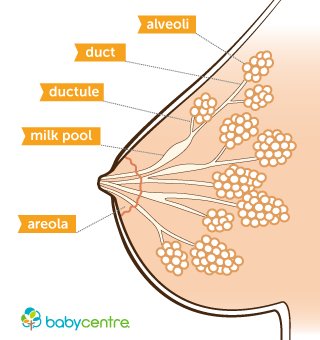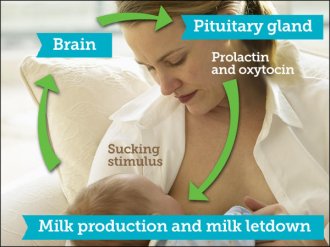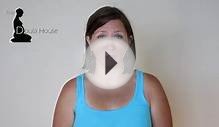

How will my breasts change in pregnancy?
Your breasts begin to gear up for feeding your baby as soon as you're pregnant. Having tingling nipples and tender, swollen breasts is one of the first signs of pregnancy (MIDIRS 2011). It's caused by hormones surging through your body.The skin around your nipples (areolas) may also appear darker, and have tiny bumps. This is nature's visual way of directing your baby towards her feed.
The tiny bumps around your areolas produce an oily substance that cleanses, lubricates and protects your nipples from infection during breastfeeding (Geddes 2007). It smells like amniotic fluid, so your baby will instinctively move towards this familiar smell soon after birth (Doucet et al 2007, Doucet et al 2012).
By the time your baby is born, the glandular tissue in your breasts may have doubled in size. The timing of this change varies from woman to women. It can happen in mid- or late-pregnancy, or even after you've given birth (Geddes 2007, MIDIRS 2011).
Don't worry if your breasts don't seem to grow much in size. There's no link between the amount of breast growth and your ability to produce milk once your baby has arrived (MIDIRS 2011). When your milk comes in after your baby is born, your breasts will feel noticeably heavier and fuller.
How do my breasts make milk?
Mammary glands in your breasts produce breastmilk. Within each mammary gland, different parts play a role in making breastmilk:- Alveoli: where breastmilk is made. These clusters of small grape-like sacs in your breast are surrounded by tiny muscles that squeeze them to push milk out into the ductules. They develop during each pregnancy (Sternlicht et al 2006).
- Ductules: small canals that carry milk from the alveoli to the main milk ducts.
- Milk ducts: the intricate network of canals that carries milk from the alveoli and ductules straight to your baby. These ducts increase in size and number during each pregnancy. The average is nine or so in each breast by the time you start breastfeeding.
- (Geddes 2007, MIDIRS 2011)
You may find you leak a few drops of milk during your pregnancy. In fact, your milk-making system will be ready to go some time during your second trimester (Geddes 2007). You'll be able to breastfeed your baby even if she arrives prematurely.
After your baby is born, and you have delivered the placenta, the oestrogen and progesterone levels in your body start to drop. This makes way for the hormone prolactin to be released from the pituitary gland in your brain (MIDIRS 2011).
 Prolactin signals your body to make lots of milk to nourish your baby, and may also make you feel more maternal.
Prolactin signals your body to make lots of milk to nourish your baby, and may also make you feel more maternal.
When can I start feeding my baby?
You can start feeding your baby as soon as she's born. Having skin-to-skin contact immediately after the birth may help:- You and your baby to bond with each other.
- Your baby's natural feeding reflexes to kick in.
- To stimulate your milk to flow (Sullivan et al 2011).
The first milk you'll feed your baby is colostrum, which is a concentrated, creamy-looking, high-protein, low-fat substance. This is all your baby needs in her first three days of her life.
Colostrum is easily-digestible and full of disease-fighting antibodies (immunoglobulins) that strengthen your baby's immune system (Kent 2007).
Your milk will come in about three days after you've given birth (Kent 2007). This is when the levels of prolactin have adjusted and you produce breastmilk, rather than colostrum.
What happens when my baby starts to feed?
For your baby to get your milk, it must be released from the alveoli, which is called letdown. Here's how it happens:- As your baby suckles, the sensation in your nipple causes another part of your pituitary gland to release oxytocin into your bloodstream.
- When oxytocin reaches your breast, it causes the tiny muscles around the milk-filled alveoli to contract and squeeze, and release milk.
- Your milk moves along to the ducts just below the areola.
- When your baby feeds, she presses the milk from the ducts into her mouth. (MIDIRS 2011)
As your milk flow increases during letdown, you may also feel some tingling, stinging, burning or prickling in your breasts (NCT 2012, Walker 2011). This is normal, and the sensation passes in a few moments.
You may find that your milk drips or even sprays as it comes down. If you have painful, engorged breasts during the first few days, feeding your baby often will help. This moves the milk through your breasts, which will help to avoid the milk staying in one of the ducts too long and causing infection (NHS Choices 2012).
You may feel some contractions in your belly during the first few days as your baby suckles (afterpains) (NCT 2012, Walker 2011). These feel like mild labour contractions. It's oxytocin getting to work again, shrinking your uterus (womb) back to its pre-pregnancy size.
YOU MIGHT ALSO LIKE












